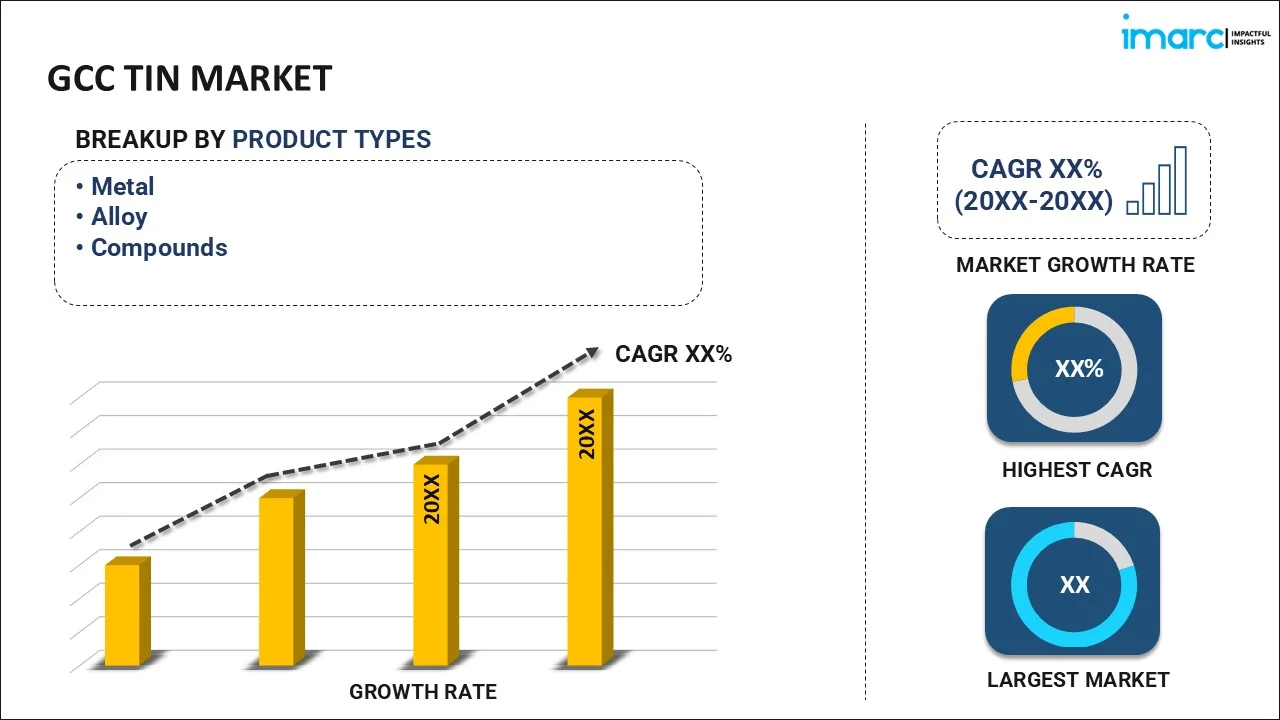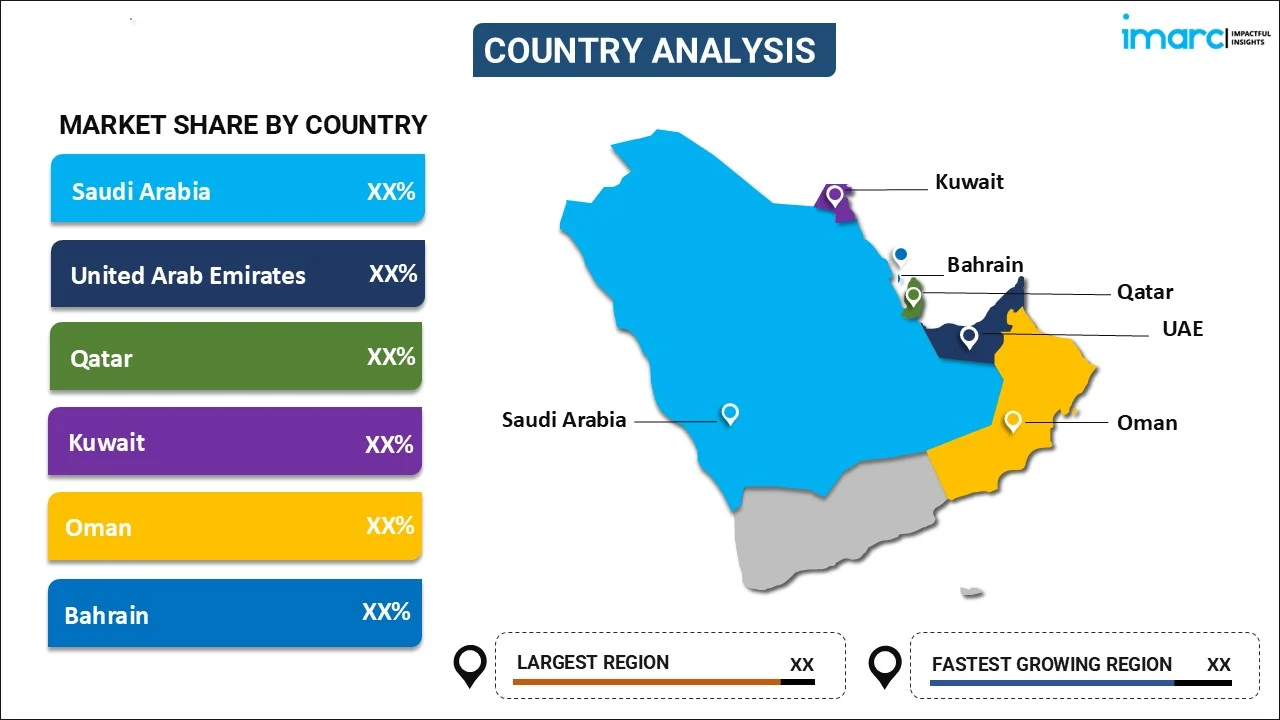
GCC Tin Market Report by Product Type (Metal, Alloy, Compounds), Application (Soldering, Tin Plating, Chemicals, and Others), End Use Industry (Automotive, Electronics, Packaging (Food and Beverages), Glass, and Others), and Country 2025-2033
Market Overview:
The GCC tin market size reached 10.1 Kilo Tonnes in 2024. Looking forward, IMARC Group expects the market to reach 13.2 Kilo Tonnes by 2033, exhibiting a growth rate (CAGR) of 2.8% during 2025-2033. The significant growth in the automotive industry, favorable government initiatives, widespread product utilization in the electronics and electrical industry and advent of sustainable and bio-based tin alternatives represent some of the key factors driving the market.
|
Report Attribute
|
Key Statistics
|
|---|---|
|
Base Year
|
2024 |
|
Forecast Years
|
2025-2033
|
|
Historical Years
|
2019-2024
|
| Market Size in 2024 | 10.1 Kilo Tonnes |
| Market Forecast in 2033 | 13.2 Kilo Tonnes |
| Market Growth Rate (2025-2033) | 2.8% |
Tin is a chemical element with the symbol "Sn" that belongs to the carbon family of elements on the periodic table. It is a silvery-white metal and is classified as a post-transition metal. Tin is relatively soft and malleable, and it has a low melting point, making it easy to work with in various applications. It is produced from the mineral cassiterite through smelting and then purified using boiling, liquation, or electrolytic methods. Tin is widely used in alloys, automotive parts, babbitt bearings, dental amalgams, aerospace metals, coatings, and polishings. It exhibits high corrosion resistance, low toxicity levels, ductility, and malleability.
GCC Tin Market Trends:
One of the key factors driving the GCC tin market is the significant growth in the automotive industry. Tin is used in the manufacturing of automotive parts, engine components, and body panels due to its lightweight and corrosion-resistant properties. In line with this, the GCC region is witnessing rapid infrastructure development, including the construction of buildings, roads, and transportation networks, which in turn is facilitating product demand. Moreover, industries in the GCC region are increasingly incorporating tin as an essential component in the production of various goods due to its corrosion resistance and low toxicity properties, which makes it an attractive option for manufacturers seeking high-quality materials for their products. Apart from this, the region's emphasis on eco-friendly practices aligns with the advent of sustainable and bio-based tin alternatives, driving the market towards greener solutions with minimal volatile organic compounds (VOCs). Furthermore, the widespread product utilization in the electrical and electronics industry for manufacturing heat-sensitive components due to its low melting point and high magnetic strength is creating a positive outlook for the market. Besides this, the emerging trends of recycling tin products, such as cans, scraps, and residue, to reduce carbon emissions, improve resource productivity and waste disposal, and save energy are positively influencing the market growth. Other factors, including growing infrastructure development projects, expanding the food and beverage (F&B) industry, increasing product adoption in dental applications, and favorable government policies, are presenting remunerative growth opportunities for the market.
GCC Tin Market Segmentation:
IMARC Group provides an analysis of the key trends in each segment of the GCC tin market report, along with forecasts at the regional and country levels for 2025-2033. Our report has categorized the market based on product type, application, and end use industry.
Product Type Insights:

- Metal
- Alloy
- Compounds
The report has provided a detailed breakup and analysis of the market based on the product type. This includes metal, alloy, and compounds.
Application Insights:
- Soldering
- Tin Plating
- Chemicals
- Others
A detailed breakup and analysis of the market based on the application has also been provided in the report. This includes soldering, tin plating, chemicals, and others.
End Use Industry Insights:
- Automotive
- Electronics
- Packaging (Food and Beverages)
- Glass
- Others
A detailed breakup and analysis of the market based on the end use industry has also been provided in the report. This includes automotive, electronics, packaging (food and beverages), glass, and others.
Country Insights:

- Saudi Arabia
- UAE
- Qatar
- Bahrain
- Kuwait
- Oman
The report has also provided a comprehensive analysis of all the major regional markets, which include Saudi Arabia, UAE, Qatar, Bahrain, Kuwait, and Oman.
Competitive Landscape:
The report has also provided a comprehensive analysis of the competitive landscape in the market. Competitive analysis such as market structure, key player positioning, top winning strategies, competitive dashboard, and company evaluation quadrant has been covered in the report. Also, detailed profiles of all major companies have been provided.
GCC Tin Market Report Coverage:
| Report Features | Details |
|---|---|
| Base Year of the Analysis | 2024 |
| Historical Period | 2019-2024 |
| Forecast Period | 2025-2033 |
| Units | Kilo Tonnes |
| Scope of the Report | Exploration of Historical and Forecast Trends, Industry Catalysts and Challenges, Segment-Wise Historical and Predictive Market Assessment:
|
| Product Types Covered | Metal, Alloy, Compounds |
| Applications Covered | Soldering, Tin Plating, Chemicals, Others |
| End Use Industries Covered | Automotive, Electronics, Packaging (Food and Beverages), Glass, Others |
| Countries Covered | Saudi Arabia, UAE, Qatar, Bahrain, Kuwait, Oman |
| Customization Scope | 10% Free Customization |
| Post-Sale Analyst Support | 10-12 Weeks |
| Delivery Format | PDF and Excel through Email (We can also provide the editable version of the report in PPT/Word format on special request) |
Key Questions Answered in This Report:
- How has the GCC tin market performed so far and how will it perform in the coming years?
- What has been the impact of COVID-19 on the GCC tin market?
- What is the breakup of the GCC tin market on the basis of product type?
- What is the breakup of the GCC tin market on the basis of application?
- What is the breakup of the GCC tin market on the basis of the end use industry?
- What are the various stages in the value chain of the GCC tin market?
- What are the key driving factors and challenges in the GCC tin market?
- What is the structure of the GCC tin market and who are the key players?
- What is the degree of competition in the GCC tin market?
Key Benefits for Stakeholders:
- IMARC’s report offers a comprehensive quantitative analysis of various market segments, historical and current market trends, market forecasts, and dynamics of the GCC tin market from 2019-2033.
- The research study provides the latest information on the market drivers, challenges, and opportunities in the GCC tin market.
- Porter's five forces analysis assist stakeholders in assessing the impact of new entrants, competitive rivalry, supplier power, buyer power, and the threat of substitution. It helps stakeholders to analyze the level of competition within the GCC tin industry and its attractiveness.
- Competitive landscape allows stakeholders to understand their competitive environment and provides an insight into the current positions of key players in the market.
Need more help?
- Speak to our experienced analysts for insights on the current market scenarios.
- Include additional segments and countries to customize the report as per your requirement.
- Gain an unparalleled competitive advantage in your domain by understanding how to utilize the report and positively impacting your operations and revenue.
- For further assistance, please connect with our analysts.
 Inquire Before Buying
Inquire Before Buying
 Speak to an Analyst
Speak to an Analyst
 Request Brochure
Request Brochure
 Request Customization
Request Customization




.webp)




.webp)












